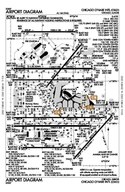The Royal Navy during the Second World War A30258
The "Lily" undulating with the waves caused by a Motor Launch passing at speed in the sea off Lamlash, Scotland. Aircraft are able to land and take off with motion of the strip. The photograph was taken during tests with the "Lily" experimental air strip, invented by Mr R M Hamilton and consisting of hexagonal buoyancy drums hinged together to form a flexible landing surface for aircraft at sea. It is 520 ft long and 60 ft across.
http://media.iwm.org.uk/iwm/mediaLib//31/media-31203/large.jpg

|
This photograph A 30258 comes from the collections of the Imperial War Museums. |
Relevante Bilder
Relevante Artikel
Start- und LandebahnDie Start- und Landebahn (SLB) oder Piste ist die – häufig befestigte – Fläche eines Flugplatzes oder Flugzeugträgers, auf der einerseits startende Flugzeuge bis zur Abhebegeschwindigkeit beschleunigen und dann abheben, andererseits landende Flugzeuge aufsetzen und abbremsen oder ausrollen. Für den Beschleunigungsweg wird eine längere Pistenlänge benötigt als für den Bremsweg der Landung. Meist werden Pisten sowohl für Starts als auch für Landungen benutzt. In seltenen Fällen können Faktoren wie zum Beispiel eine Hindernissituation oder eine spezielle Rolllogistik eine ausschließliche Nutzung für Starts oder Landungen bedingen. Dies ist z. B. am Flughafen Frankfurt Main der Fall. .. weiterlesen
















